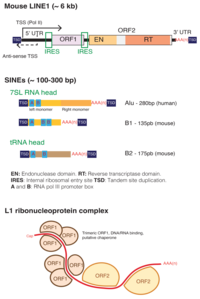
Photo from wikipedia
Long interspersed nuclear elements 1 (LINE1) are non-LTR retrotransposons that represent the greatest remodeling force of the human genome during evolution. Genomically, LINE1 are constituted by a 5´ untranslated region… Click to show full abstract
Long interspersed nuclear elements 1 (LINE1) are non-LTR retrotransposons that represent the greatest remodeling force of the human genome during evolution. Genomically, LINE1 are constituted by a 5´ untranslated region (UTR), where the promoter regions are located, three open reading frames (ORF0, ORF1, and ORF2) and one 3´UTR, which has a poly(A) tail that harbors the short interspersed nuclear elements (SINEs) Alu and SVA. Although the intrinsic nature of LINE1 is to be copied and inserted into the genome, an increase in their mobility produces genomic instability. In response to this, the cell has "designed" many mechanisms controlling the retrotransposition levels of LINE1; however, alterations in these regulation systems can increase LINE1 mobility and the formation of chimeric genes. Evidence indicates that 988 human genes have LINE1 inserted in their sequence, resulting in the transcriptional control of genes by their own promoters, as well as by the LINE1 antisense promoter (ASP). To date, very little is known about the biologic impact of this and the L1-MET chimera is a more or less studied case. ASP hypomethylation has been observed in all studied cancer types, leading to increased L1-MET expression. In specific types of cancer, this L1-MET increase controls both low and high MET protein levels. It remains to be clarified if this protein product is a chimeric protein.
Journal Title: Cancer genetics
Year Published: 2019
Link to full text (if available)
Share on Social Media: Sign Up to like & get
recommendations!